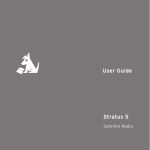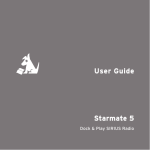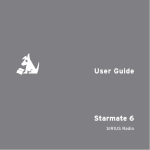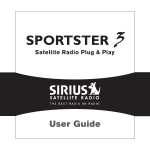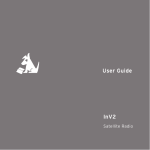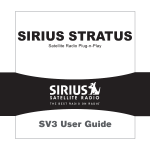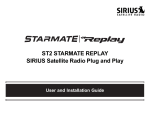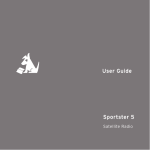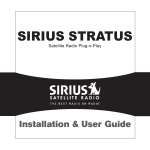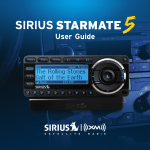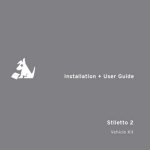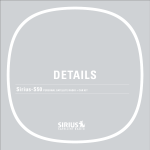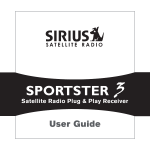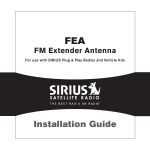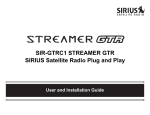Download Starmate 5 User Guide
Transcript
User Guide Starmate 5 Plug & Play SIRIUS Radio Here’s your new SIRIUS® Starmate ST5 Plug & Play Radio Your new SIRIUS Starmate ST5 Plug & Play Radio comes with everything you need to enjoy SIRIUS® in your car. And with available SIRIUS Universal Docking accessories you can use your Starmate ST5 just about anywhere. Your new Starmate ST5 gives you powerful features: >> SIRIUS Replay™ — Pause, rewind and replay up to 44 minutes of live radio. >> Memo function — Store up to 30 favourite songs and artists plus a favourite sports team or NASCAR® car and get an alert whenever they’re playing on any channel. >> Easy-to-read wide-angle 5-line display. >> Built-in wireless FM transmitter so you can listen to SIRIUS through your car’s FM stereo. An FM Presets button makes transmitter frequency changes quick and easy. >> Full-function wireless remote control Use this manual to familiarize yourself with all of your SIRIUS Starmate ST5’s features and capabilities. For the latest information about your ST5 and other SIRIUS products and accessories, visit http://www.siriuscanada.ca. Table of Contents Table of Contents 4 Warning & Safety Information 6 Canadian Compliance General Precautions Warnings Copyrights & Trademarks Package Contents Installation Installing the Vehicle Dock Installing the Magnetic Antenna Connecting the Cigarette Lighter Adapter Docking the Starmate ST5 Cable Separation and Routing Connecting the Starmate ST5 to Your Vehicle’s Audio System Subscribing to the SIRIUS Service 6 7 9 10 11 14 14 21 37 38 39 41 48 Controls49 Starmate ST5 Remote Control Buttons Vehicle Dock Reference Guide Display Screen Information Operation Changing Channels and Categories Table of Contents 51 54 55 55 56 Display (Disp) Button Selecting Channels Directly (Direct Tuning) Channel Presets (Band Button) Memory (Memo) and Song Seek (S-Seek) Functions Jump Button SIRIUS Replay FM Presets Button Menu Options Sirius ID FM Transmitter Settings Parental Control Time Based Features Signal Indicator Factory Default 58 59 60 62 70 71 76 78 78 79 80 86 88 94 95 Troubleshooting 97 Specifications 98 SIRIUS ID 99 Table of Contents Warning & Safety Information Warning Changes or modifications not expressly approved by the manufacturer could void the user’s authority to operate the equipment. Canadian Compliance This Class B digital apparatus complies with Canadian ICES-003. IC STATEMENT Operation is subject to the following two conditions: (1) this device may not cause interference, and (2) this device must accept any interference, including interference that may cause undesired operation of the device. For product available in the Canada market, only channel 1~11 can be operated. Selection of other channels is not possible. This device and its antenna(s) must not be co-located or operation in conjunction with any other antenna or transmitter. To reduce potential radio interference to other users, the antenna type and its gain should be so chosen that the equivalent isotropically radiated power (e.i.r.p) is not more than that permitted for successful communication. IC Radiation Exposure Statement: This equipment complies with IC RSS-102 radiation exposure limits set forth for an uncontrolled environment. This equipment should be installed and operated with minimum distance 20cm between the radiator & your body. Warning and Safety Information General Precautions Liquid Crystal Precautions If the LCD screen on the radio is damaged, do not to touch the liquid crystal fluid. If any of the following situations happen, take the action indicated: 1. If the liquid crystal fluid comes in contact with your skin, wipe the skin area with a cloth and then wash the skin thoroughly with soap and running water. 2. If the liquid crystal fluid gets into your eye, flush the eye with clean water for at least 15 minutes. Seek medical care. 3. If the liquid crystal fluid is ingested, flush your mouth thoroughly with water. Drink large quantities of water and induce vomiting. Seek medical care. Safety Precautions Be sure to observe the following warnings. Failure to follow these safety instructions and warnings may result in a serious accident. • Do not operate your SIRIUS ST5 in a way that might divert your attention from driving safely. As a driver, you alone are responsible for safely operating your vehicle in accordance with traffic safety laws at all times. • Do not install the radio where it may obstruct your view through the windshield, or of your vehicle’s indicator displays. • Do not install the radio where it may hinder the function of safety devices such as an airbag. Doing so may prevent the airbag from functioning properly in the event of an accident. • Be sure the radio and accessories are installed as described in these installation instructions and the instructions which accompany each accessory kit. SIRIUS Satellite Radio is not responsible for issues arising from installations which were not installed according to the instructions. • Before attaching the suction cup mount to your windshield, you should check your state and local laws for regulations regarding mounting this device on your windWarning and Safety Information shield. • To avoid short circuits, do not open the radio or accessories, and never put or leave any metallic objects (coins, tools, etc.) inside the radio. • If the radio or accessories emit smoke or unusual odors, turn the power off immediately, and disconnect the radio from any power source. • Do not drop the radio or subject it to strong shocks. • If your ST5 doesn’t seem to be working properly, turn it off, wait 10 seconds and then turn it on again. • The installation and use suggestions contained in this manual are subject to any restrictions or limitations that may be imposed by applicable law. The purchaser should check applicable law for any restrictions or limitations before installing and/ or operating this unit. • Do not install the FM Transmitter Antenna where it will hinder or block your view. In some states it may be illegal to mount it on the windshield of your vehicle. Check applicable law for any restrictions or limitations before installing the FM Extender Antenna on your windshield. • Do not install the FM Transmitter Antenna where it may hinder the function of safety devices such as an airbag. Doing so may prevent the airbag from functioning properly in the event of an accident. Warning and Safety Information Warnings Operating Temperature The radio is designed to operate between -20° to +85° C (-4° to +185° F). Avoid leaving the radio in a vehicle or elsewhere where the temperature may fall outside this range. Extreme temperatures or extreme temperature fluctuations can degrade the performance of the LCD display screen, and possibly damage it. Cleaning and Maintenance If the radio or accessories become dirty, turn the power off and wipe it clean with a soft cloth. Do not use hard cloths, strong cleaning fluids, paint thinner, alcohol, or other volatile solvents to clean. These may cause damage to the radio. Cigarette Lighter Adapter The Vehicle Dock cannot be powered directly from a vehicle’s 12VDC power system. It must be powered from the vehicle’s cigarette lighter or similar power port using the included Cigarette Lighter Adapter or an equivalent DC power adapter (see your local electronics dealer). Connecting the Vehicle Dock directly to the vehicle’s 12VDC power system may result in damage to the Vehicle Dock or SIRIUS radio, or both. Warning and Safety Information Copyrights & Trademarks © 2008 SIRIUS Satellite Radio Inc. All Rights Reserved. ® “SIRIUS”, the SIRIUS dog logo, channel names and logos are trademarks of SIRIUS Satellite Radio Inc. All other trademarks, service marks, sports team names, album art, and logos are the property of their respective owners. All Rights Reserved. ™ “Starmate” is a trademark of SIRIUS Satellite Radio. Portions of the software on this radio are licensed under the eCos License. Distribution of eCos requires that the eCos source code be made available to Sirius Satellite Radio customers. The eCos License and eCos source code are available to the public at http://www.sirius.com/ecoslicense. Sirius Satellite Radio reserves all rights to all radio software not covered under the eCos license. This includes all portions of radio software that were not distributed to Sirius as part of the eCos operating system. Hardware, subscription and activation fee required. For full Terms & Conditions, visit http://siriuscanada.ca. Prices and programming are subject to change. Not available in HI and AK. Equipment and subscription sold separately. Installation required with some equipment. 10 Copyrights & Trademarks Package Contents The following items are included with your SIRIUS Starmate ST5 radio: Starmate ST5 Radio Remote Control Vehicle Dock Package Contents 11 Suction Cup Mount Magnetic Antenna 12 Package Contents Vent Mount & Extended Vent Hooks Antenna Cover/Tail Mounting Screws Cigarette Lighter Adapter Alcohol Swab Unpack your SIRIUS Starmate ST5 radio carefully and make sure that everything shown is present. If anything is missing or damaged, or if your SIRIUS Starmate ST5 fails to operate, notify your dealer immediately. We recommended that you retain the original carton and packing materials in case you need to ship your radio in the future. Package Contents 13 Installation SIRIUS suggests that you have your Starmate ST5 professionally installed in your vehicle. Professional installation provides an experienced technician to install this product in your vehicle, advice for selecting a suitable mounting location for the Vehicle Dock, installation of the antenna, and proper routing of all the necessary wires and cables. If the locations of your Starmate ST5 and your vehicle’s FM antenna make the performance the ST5’s built-in FM transmitter within your vehicle poor, a professional installer will have the necessary accessories to install an optional FM Direct Adapter or an audio cable to connect the audio output of the Vehicle Dock directly to your vehicle’s audio system. Ask your SIRIUS retailer if they provide professional installation services, or can recommend a professional installation service. Installing the Vehicle Dock When installing the Vehicle Dock in your vehicle, choose a location in your vehicle where it will not block your vision, interfere with the vehicle controls, or obstruct the air bag. The location should be easily accessible and provide good visibility of the display, and should not be located where it will be in direct sunlight which will affect the visibility of the display screen. The mounting accessories necessary to install the Vehicle Dock in a vehicle are provided. Figure 1 shows two examples of the SIRIUS radio mounted in a vehicle: A is the suction cup mount method, and B is the vent mount method using the vent mount clip. 14 Installation A. B. A. B. Figure 1 Depending upon the mounting location you select in your vehicle, the mount should be attached to the vehicle dock and installed as described in the following sections. Installation 15 Suction Cup Mount Method (A) The suction cup mount may be attached to any smooth surface. Before attaching the suction cup mount to your windshield, you should check your state and local laws for regulations regarding mounting this device on your windshield. Attach Dock to Mount with Included Screws Figure 2 To mount the vehicle dock using the suction cup mount, assemble the mount as follows: 1. Attach the vehicle dock to the suction cup mount using the provided screws (see Figure 2). 2. Clean the area where you are attaching the suction cup with the supplied alcohol wipe. 16 Installation 3. Be sure the cam lever is up (as shown in Figure 3) and position the suction cup mount on the windshield or other location you which have chosen. Press the cam lever all the way down towards the base of the mount until it locks to adhere the suction cup. (To unlock the suction cup, lift the lever up.) Press Lever Down To Lock Mount Figure 3 Installation 17 Vent Mount Method (B) To mount the vehicle dock using the vent mount method, install the vent mount as follows: 1. If the vent louvers in your vehicle are recessed, you may need to use the longer vent hooks with the vent mount. Refer to Figure 4 and install the longer vent hooks into the vent mount. Be sure to observe the orientation of the vent hooks as shown. 2. Attach the vent mount to the vehicle dock using the provided screws (see Figure 5). Remove End Cap Slide Short Vent Hooks Out Slide Extended Vent Hooks In Replace End Cap Figure 4 Attach Dock to Mount with Included Screws Figure 5 18 Installation 3. Refer to Figure 6 and attach the vent mount to a heating/air conditioning vent in your vehicle. Position the two tension springs A against a vent louver B. Then push the vent mount into the vent, far enough so that the hooks C drop down and hook the rear of the vent louver (see Figure 7). Once you are sure that the hooks have grasped a vent louver, the tension springs A will keep the vent mount hooked to the louver. A B PUSH C FM OUT ANT D Figure 6 FM OUT HOOKED ANT Figure 7 Installation 19 4. You can change the angle of the vehicle dock by changing the position of foot D on the vent mount to a different adjustment hole (see Figure 8). FM OU T ANT ADJUSTMENT HOLES Figure 8 20 Installation D Installing the Magnetic Antenna Caution Because adhesive is used in the installation of the Rubber Antenna Cover/Tail, we recommend that you install the antenna at or above room temperature (68° F). The adhesive on the Rubber Cover/Tail may not adhere properly to the vehicle roof at temperatures lower than this. Warmer temperatures will also make it easier to route of the antenna cable through the rubber molding around the windows and in other areas in the vehicle. Maximum adhesion usually occurs within 72 hours at room temperature, so you should avoid car washes as well as other contact with the antenna and Rubber Cover/Tail during this 72-hour period. Warning Be sure not to cut, damage, or puncture the external jacket of the antenna cable during the installation procedure. Damage to the antenna cable can degrade the SIRIUS signal or make it unavailable, and can also cause water to intrude via the cable into the antenna causing the antenna to fail. Do not lengthen or shorten the antenna cable by cutting it. Doing so will cause the antenna to not function properly. Installation Installing the magnetic antenna consists of two steps: • Mounting the magnetic antenna and Rubber Antenna Cover/Tail on the vehicle • Routing the antenna cable through the vehicle to the Vehicle Dock Installation 21 Antenna Mounting The SIRIUS Magnetic Mount Vehicle Antenna has a strong magnetic mount designed to hold it in place during normal driving conditions (highway/city). This also makes the antenna easy to remove for transferring it to other vehicles. Figure 9 shows the optimal mounting location for the antenna on several types of vehicles. These mounting positions should be observed when installing the antenna: Sedan/Coupe Pickup Truck SUV/Mini-Van Convertible Figure 9 • Sedan/Coupe/SUV/Mini-Van: Install the antenna at the rear center of the roof, near the rear window. • Pickup Truck: Install the antenna at the front center of the roof, near the windshield. • Convertible: Install the antenna at the front center of the trunk lid, near the rear window. 22 Installation The SIRIUS antenna needs to have an unobstructed area of 3 inches by 3 inches around it. It is important to mount the antenna where no obstructions will block the antenna from receiving the SIRIUS signal. Objects which can obstruct the antenna could be a roof rack, a sunroof, a roof-mounted cargo container, another antenna, etc. If your vehicle has a potential obstruction, be sure that the SIRIUS antenna is mounted at least 3 inches away from it (but no closer than 3 inches from the edge of the roof or trunk lid). Note: Read the Do and Do Not installation tips beginning on page 32 for additional antenna installation information. Follow this procedure to mount the antenna: 1. Select an appropriate mounting position for your type of vehicle that has an unobstructed area of 3 inches by 3 inches around the antenna. 2. Attach the Rubber Cover/Tail to the antenna, as shown in Figure 10, and press the antenna cable into the rubber cover/tail. The Rubber Cover/Tail will help to position the antenna the correct distance from the edge of the roof or trunk lid. Protective Strips Strain Relief Rubber Antenna Cover/Tail Cable Magnetic Antenna (Upside-Down) Figure 10 3. Clean the surface area of the vehicle where you will be installing the antenna with the alcohol prep pad. Installation 23 4. Peel the protective material from the adhesive strips (see Figure 10, on page 23) and press the rubber Cover/Tail firmly into place on the vehicle. 5. Double check that the location of the antenna and rubber cover/tail are correct, and continue to press firmly down on the Rubber Cover/Tail for another 30 seconds. At room temperature (68° F), maximum adhesion usually occurs within 72 hours. During this period, avoid car washes and other contact with the antenna and the Rubber Antenna Cover/Tail. Cable Routing After you have mounted the antenna you can route the antenna cable to the SIRIUS Vehicle Dock. Separate antenna cable routing procedures are provided for each type of vehicle: Sedan/Coupe, Pickup Truck, SUV/Mini-Van and Convertible. Note that additional breakout illustrations for each step of the antenna cable routing procedures can be found on the SIRIUS website at http://www.siriuscanada.ca. Click on the Install/Activate link and then follow the link for the Car Installation Tips. 24 Installation Sedan/Coupe Antenna Cable Routing Procedure Figure 11 shows how the antenna cable should be routed from the antenna to your Starmate ST5 in a sedan/coupe. 1. Feed Cable Under Rubber Molding Around Window 2. Route Cable Out of Window Molding and Into Weatherstripping Around Trunk Opening 6. Bring Cable Out To SIRIUS Receiver Location ANTENNA 5. Bring Cable out from Trim and Route Under Carpet to Dashboard or Console. 3. Route Cable Along Trunk Wall and Into Cabin 4. Route Cable from Trunk Under Interior Trim, into Cabin and Towards Front of Vehicle Figure 11 Follow these detailed cable installation instructions: 1. Feed the cable from the antenna underneath the rubber molding around the rear window. Use a plastic putty knife or similar object to lift the rubber molding around the rear window and tuck the antenna cable underneath the molding. Route the antenna cable around and down the window to the lowest point. If your rear window does not have rubber molding, SIRIUS recommends consulting with a professional installer. Installation 25 2. Route the antenna cable out of the window molding and into the rubber weather stripping around the trunk opening. Lift the weather stripping from the opening and tuck the cable inside it, then replace the weather stripping. To avoid sharp bends in the cable, run the cable inside of the weather stripping for a few inches, then remove the cable from the weather stripping inside of the trunk. Keep the cable away from hinges, gears, etc., that could damage it. 3. Route the cable out from the rubber weather stripping and along the trunk wall. Continue routing the cable into the cabin through a conduit or along an existing wiring harness. 4. Route the cable through the main cabin area under the interior trim, towards the front of the vehicle. Use the plastic putty knife to lift the plastic trim just enough to tuck the cable under underneath. Avoid side airbag locations on back pillars and above the doors. (Airbag locations are marked with “SRS” logos.) Be careful not to crimp or cut the cable. 5. Bring the cable out from the trim near the firewall and route it under the carpet toward the dashboard or console. Coil any excess cable in a hidden location, such as under the carpet, keeping it away from any vehicle pedals or controls. Secure the excess cable with wire ties. 6. Bring the end of the cable out at the SIRIUS Vehicle Dock location. Leave yourself enough cable so you can easily connect it to the antenna connector on the Vehicle Dock. 26 Installation Pickup Truck Antenna Cable Routing Procedure Figure 12 shows how the antenna cable should be routed from the antenna to your Starmate ST5 in a pickup truck. ANTENNA 2. Continue Tucking Cable Under Molding To Bottom of Windshield 1. Route Cable Under Rubber Molding Around Windshield 5. Bring Cable Out to SIRIUS Receiver Location 4. Bring Cable out from Weatherstripping and Route Under Carpet 3. Route Cable Out of Molding and Into Weatherstripping Around Door Opening. Continue to Bottom of Door Opening. Figure 12 Follow these detailed cable installation instructions: 1. Use a plastic putty knife or similar tool to lift the rubber molding around the windshield and tuck the antenna cable underneath it. 2. Continue tucking the cable underneath the windshield molding around the windshield to the lowest corner. Installation 27 3. At the lowest corner of the windshield, route the cable out of the windshield molding and into the rubber weather stripping around the door opening. Lift the weather stripping from the opening and tuck the cable inside it, then replace the weather stripping. Run the cable inside of the weather stripping to the bottom of the door opening. 4. Pull the cable out of the weather stripping at the bottom of the door opening and route it under the carpet toward the dashboard. Coil any excess cable in a hidden location, such as under the carpet, keeping it away from any vehicle pedals or controls. Secure the excess cable with wire ties. 5. Bring the end of the cable out at the SIRIUS Vehicle Dock location. Leave yourself enough cable so you can easily connect it to the antenna connector on the Vehicle Dock. SUV/Mini-Van Antenna Cable Routing Procedure Figure 13 (oppposite) shows how the antenna cable should be routed from the antenna to your Starmate ST5 in an SUV or a Mini-Van. 28 Installation 1. Feed Cable Under Rubber Seal Around Hatch Opening 4. Bring Cable Out To SIRIUS Receiver Location ANTENNA 3. Route Cable Under Carpet to Dashboard 2. Route Cable Under Interior Trim, into Cabin and Towards Front of Vehicle Figure 13 Follow these detailed cable installation instructions: 1. Feed the antenna cable underneath the rubber weather stripping of the rear tailgate window/door and route the cable along the rear hatch. Lift the weather stripping from the opening and tuck the cable inside it, then replace the weather stripping. Pull the cable out from weather stripping and route it into the cabin under the interior trim. Avoid hinges or gears that could crimp or cut the cable. 2. Route the cable through the SUV’s main cabin area under the interior trim, towards the front of the vehicle. Use a plastic putty knife to lift the plastic trim just enough to tuck the cable under underneath. Avoid side airbag locations on back pillars and above the doors. (Airbag locations are marked with “SRS” logos.) Be careful not to crimp or cut the cable. Installation 29 3. Bring the cable out from the trim near the firewall and route it under the carpet toward the dashboard or console. Coil any excess cable in a hidden location, such as under the carpet, keeping it away from any vehicle pedals or controls. Secure the excess cable with wire ties. 4. Bring the end of the cable out at the SIRIUS Vehicle Dock location. Leave yourself enough cable so you can easily connect it to the antenna connector on the Vehicle Dock. Convertible Antenna Cable Routing Procedure Figure 14 shows how the antenna cable should be routed from the antenna to your Starmate ST5 in a convertible. 6. Bring Cable Out To SIRIUS Receiver Location 1. Bring Cable from Antenna Into Inside of Trunk Lid 5. Bring Cable out from Trim and Route Under Carpet to Dashboard or Console. ANTENNA 4. Route Cable from Trunk Under Interior Trim, into Cabin and Towards Front of Vehicle 2. Tape Cable Along Inside of Lid to Hinge Strut 3. Tie Cable to Hinge Strut, Allowing Slack for Lid to Open and Close. Route Cable Into Cabin Through Existing Wire Channel. Figure 14 30 Installation Follow these detailed cable installation instructions: 1. 2. 3. 4. 5. Bring the cable from the antenna into the trunk at the front edge of the trunk lid. Keep any bends in the cable loose. Tape or tie the cable along the inside of the trunk lid to the trunk lid hinge strut. Allow enough slack in the cable so the trunk lid can easily open and close and keep the cable away from hinges, gears, etc., that could crimp or cut it. Route the cable along the trunk wall and into the cabin through a conduit or along an existing wiring harness. Route the cable through the main cabin area under the interior trim, towards the front of the vehicle. Use a plastic putty knife to lift the plastic trim just enough to tuck the cable under underneath. Avoid side airbag locations on back pillars and above the doors. (Airbag locations are marked with “SRS” logos.) Be careful not to crimp or cut the cable. Bring the cable out from the trim near the firewall and route it under the carpet toward the dashboard or console. Coil any excess cable in a hidden location, such as under the carpet, keeping it away from any vehicle pedals or controls. Secure the excess cable with wire ties. Bring the end of the cable out at the SIRIUS Vehicle Dock location. Leave yourself enough cable so you can easily connect it to the antenna connector on the Vehicle Dock. Installation 31 Tip Antenna Installation Tips The following Do and Do Not antenna mounting tips illustrate how to install the antenna for optimal performance, and also illustrate where the antenna should not be installed. DO Mount the antenna on the roof, at least 3 inches from the edge. DO Mount the antenna on the roof where it has a clear view of the sky in all directions. 32 Installation DO Mount the antenna on the roof where it has at least 3 inches of clear space around it. DO Use the supplied Rubber Tail Cover to protect the antenna cable. 3” Installation 33 Do Not Don’t mount the antenna inside the vehicle, for example, on the dashboard. Do Not Don’t mount the antenna on any of the vehicle’s front, back or side pillars. 34 Installation Do Not Don’t mount the antenna close to a roof rack. Adjust the rack so it’s further away from the antenna or move the antenna closer to the center of the roof. Do Not Don’t mount the antenna close to another antenna. Mount it at least 3 inches away. Installation 35 Do Not Don’t mount the antenna closer than 3 inches from the edge of the roof. Use the supplied rubber tail/cover as a guide for judging proper length and correct positioning. After you’ve routed the cable to the SIRIUS Vehicle Dock, connect the antenna cable to the Ant connection on the left side of the Vehicle Dock. (See Figure 15.) Antenna Connection FM OUT ANT Vehicle Dock (Right Side) Figure 15 36 Installation Antenna Cable Connector Connecting the Cigarette Lighter Adapter Connect the provided cigarette lighter adapter to the Pwr connector on the right side of the Vehicle Dock (see Figure 16). Cigarette Lighter Adapter Vehicle Dock (Left Side) Power Connection 12V Power Outlet PWR AUDIO Figure 16 Important: Do not power the Vehicle Dock directly from your vehicle’s 12VDC power system without using the Cigarette Lighter Adapter. Doing so could damage the Vehicle Dock, your Starmate ST5 or both. Installation 37 Docking the Starmate ST5 To place your SIRIUS ST5 into the Vehicle Dock, align the radio against the rear of the Dock so that the rails on the Dock fit into the mounting slots in the back of the radio (see Figure 17). Slide the radio all the way down onto the Dock so that it fits firmly. Mounting Rails Figure 17 38 Installation Cable Separation and Routing FCC Information The satellite antenna cable, FM transmitter antenna (FMTA) cable and cigarette lighter adapter (CLA) power cable must be appropriately separated and routed for your radio to be compliant with federal regulations. Step 1 The connections on your vehicle dock are clearly marked. Install your vehicle dock and connect the antenna cable into the connection labeled “ANT”, the CLA power cable into the power connection marked “PWR” and the FTMA cable into the connection marked “FM OUT”. (See Figure 18.) Step 2 LEFT RIGHT Power PWR FTMA Antenna AUDIO Figure 18 It is important that you keep the three cables as separate from each other as possible and that you keep the two antenna cables away from the vehicle dock and from the CLA power cable. The cables must not be bundled together as they exit the dock (see Figure 19, on page 40). As a guide, you can follow the diagram in Figure 19, adapting the example to suit your own vehicle’s configuration. For example, if you cigarette lighter socket is to the left of the vehicle dock, route the two antenna cables towards the passenger side of the vehicle. If your cigarette lighter socket is on the right-hand side of the vehicle dock, route the two antenna cables towards the driver’s door. The CLA cable and antenna cables MUST be routed in opposite directions. Safely conceal all antenna cables within door, carpet or cash panels to prevent snags and interference. Installation 39 Step 3 Coil any excess cable between the cigarette lighter socket and vehicle dock, keeping it away from vehicle pedals or controls to prevent any slack which might interfere with the safe operation of your vehicle. Secure the excess cable with wire ties. If possible, tuck the coiled part in a hidden location, such as in between the carpet and plastic panel of the front console (see Figure 20). Antenna Cable Power Cable FTMA Cable Hide Excess Cable Power Cable Figure 19 Step 4 Follow the instructions in this manual to install, route and hide the antenna cable and the FTMA cable. Be sure to coil and secure any excess cable in a hidden location, such as under the carpet on the passenger side, keeping it away from vehicle pedals and controls. The bundled cables should be as far away from the CLA power cable as possible (see Figure 21). 40 Installation Figure 20 D. Route Cable Under Carpet or Console to vehicle dock or SIRIUS radio C. Coil Excess Cable Under Carpet or Mat B. Pull Carpet or Mat Back A. Bring Antenna Cable out from Trim Figure 21 Connecting the Starmate ST5 to Your Vehicle’s Audio System There are two ways to connect your SIRIUS Starmate ST5 to your vehicle’s audio system: Direct Connection or Wireless Connection. Which one will perform best in your vehicle depends on your vehicle’s audio system. For the latest information go to http://www. siriuscanada.ca/vehicleinstallation. Direct Wired Audio Connection If your vehicle’s audio system has an “Aux In” or “Line In” jack it is the best-quality audio connection you can use for your SIRIUS radio. (And if the Aux In or Line In connector is located somewhere on the front of your vehicle radio or elsewhere in the cabin, this is also the easiest way to connect your SIRIUS receiver.) 1. Purchase an audio cable that matches the connection type of your vehicle’s audio system and your SIRIUS Vehicle Dock at your local electronics retailer. • The Vehicle Dock requires a male 1/8” stereo connector. 2. Plug the cable’s male 1/8” stereo connector into the Audio jack on the left side of the Vehicle Dock. Plug the other end into the Aux In/Line In connector on your vehicle’s audio system (see Figure 22). Vehicle Dock (Left Side) Vehicle Radio AUDIO Jack To AUX IN or LINE IN Connector PWR AUDIO Stereo Cable (Sold Separately) Figure 22 Installation 41 Direct FM Audio Connection If your vehicle’s audio system does not have an Aux In/Line In connection, a SIRIUS FM Direct Adapter (sold separately) will provide the next-best quality connection between your Starmate ST5 and your vehicle radio. You will listen to your ST5 through your car radio’s FM tuner, but the SIRIUS FM Direct Adapter connects your vehicle’s FM radio directly to the Vehicle Dock’s FM Out jack, eliminating the outside static and interference you sometimes experience when using a wireless FM connection (see Figure 23). Vehicle Antenna Vehicle Radio FM Direct Adapter (Sold Separately) Antenna Connection Vehicle Dock (Right Side) FM OUT Jack FM OUT ANT Figure 23 NOTE: Professional installation may be required. See your local SIRIUS retailer. The SIRIUS FM Direct Adapter is available at your local SIRIUS retailer or at http://shop.siriuscanada.ca. Follow to the instructions included with the FM Direct Adapter. 42 Installation Cassette Adapter If your vehicle’s audio system has a cassette player you can purchase a cassette adapter from your local electronics retailer or from SIRIUS at http://shop.siriuscanada.ca. Plug the adapter’s connector into the Audio jack on the left side of the Vehicle Dock, and insert the adapter into your vehicle’s cassette player (see Figure 24). Cassette Adapter (Sold Separately) Vehicle Dock (Left Side) Vehicle Radio AUDIO Jack PWR AUDIO Figure 24 Note: Refer to the cassette adapter’s instructions for correct use. Installation 43 Wireless Connection If you cannot connect your SIRIUS radio directly to your vehicle’s audio system, your Starmate ST5 contains an FM transmitter that will ‘broadcast’ its audio to your vehicle’s FM radio. To use this you need to tune the ST5’s FM transmitter to an FM frequency that’s not being used in your area (If you use an FM channel that is being used by a local broadcaster, it will interfere with your ST5’s performance.) See Figure 25. Vehicle FM Antenna menu disp MEMO band 1 Vehicle Radio 2 3 4 5 6 7 8 9 0 SIRIUS Starmate ST5 Match Channels Figure 25 1. Tune through your vehicle radio’s FM channels to find an FM channel (between 88.1MHz and 107.9MHz) that is not broadcasting in your area. 2. Once you have located an FM channel that is not broadcasting in your area, save it as a preset on your vehicle radio. This will become your SIRIUS preset. 3. Dock your Starmate ST5 and turn its power ON. Wait for the Channel Update to finish before pressing any buttons. 44 Installation 4. Press and hold the FM Presets button (see Figure 26). The FM Presets screen will appear, with FM1 highlighted. FM1 is factory-set to 88.1MHz. This may not be the best frequency for your area (see Figure 27). FM PRESETS Button Channel UP/DOWN Buttons SELECT Button Figure 26 Figure 27 5. Press the Select button. The FM1 frequency screen will appear (see Figure 28, left). Figure 28 se the Channel UP/DOWN buttons to highlight the FM frequency that matches 6. U the channel that you preset on your vehicle radio in Step 2, then press the Select button to select it (see Figure 28, right). To listen to your SIRIUS radio, turn your SIRIUS radio ON, then turn your vehicle’s FM radio ON and press the SIRIUS preset you set in Step 2, on page 44. Installation 45 Tip If you regularly travel between cities with different active FM channels, you may need to find channels that are not broadcasting in each city. Your Starmate ST5 can store up to 5 preset FM transmit channels (see Figure 27, on page 45), so you can easily switch to the best FM channel for each city. • To switch the FM transmit preset, press the FM Presets button on the ST5 front panel, or the remote. (See pages 49 – 52) If you’re not sure which FM channels are not broadcasting in your home or travel cities, you can also go to http://www.siriuscanada.ca/fmchannel and search for a suggested FM channel based on your zip code. 46 Installation Installing the FM Transmitter Antenna Note: You will only need to install the FM Transmitter Antenna (FMTA) if you are using the wireless connection option. The use of the FMTA is highly recommended to improve your audio quality. The FMTA brings the FM signal transmitted by your SIRIUS radio closer to your vehicle’s FM antenna to provide a strong FM signal for good reception. To install the FTMA: 1. Connect the FMTA to the vehicle dock. Insert the FMTA 2.5 mm plug into the FM OUT connector of the vehicle dock. (See Figure 29, left.) 2. Position FMTA inside the vehicle. The FMTA wire should be run with the power adaptor wire, and placed on the dash board or even placed under the dash pad (if possible). (See Figure 29, right.) If your Stiletto is mounted to the center console, the FTMA wire should be run along console. 3. Hide the wires. Depending on the position of your Stiletto, hide the wires by tucking them into the seams in the dash board or the console seams where possible. “FM OUT” JACK 2.5 MM PLUG Figure 29 Installation 47 Subscribing to the SIRIUS Service Before you can listen to the SIRIUS service, you need to subscribe to the SIRIUS Satellite Radio service. To subscribe, do the following: 1. Be sure that your SIRIUS Starmate ST5 is correctly installed, is properly docked in the Vehicle Dock, and that the antenna is oriented to receive the SIRIUS signal. Figure 30 2. Turn on the ST5. After the startup sequence, it will update the SIRIUS channel line-up (see Figure 30). Wait until the channel updates have completed before pressing any buttons. 3. Once the channels have been updated, the ST5 Figure 31 will automatically tune to channel 184 and the display will change to To Activate Call 1-888-539SIRIUS (see Figure 31). You will not be able to listen to any other channels until you activate your SIRIUS subscription. 4. To display your Starmate ST5’s SIRIUS ID (SID) Figure 32 number, tune to channel 0 by pressing the Select button, then the 0 (zero) button, and then the Select button again (see Figure 32). The SID number is also available on your ST5’s packaging. Write the SID number down. Figure 33 5. Have your credit card handy and contact SIRIUS on the Internet at home.siriuscanada.ca/. You can also call SIRIUS toll-free at: 1-888-539-SIRIUS. 6. When you have successfully subscribed to the SIRIUS service an alert will be displayed (see Figure 33). To continue, press any button on the front panel. You are now ready to begin enjoying SIRIUS Satellite Radio’s digital entertainment, and can tune to other channels! 48 Installation Controls Starmate ST5 Front Panel Figure 34 and the section following identify and describe your SIRIUS Starmate ST5’s buttons and controls. 1 2 3 4 5 6 7 15 8 14 13 9 12 11 10 Figure 34 1. Menu Button: Accesses Menu options to make setup and feature changes. 2. Display (Disp) Button: Toggles the Default display screen between the normal display mode and large text display mode (see page 59). Pressing and holding switches the display to the My Channels screen (see page 58). 3. Memory (Memo) Button (S-Seek Function): Saves and recalls artist names, song titles, and sports teams. You can store up to 30 artist/song title combinations, including your favourite sports teams/cars and traffic channels. Pressing and holdControls 49 ing the Memo button will enter the recall mode, displaying the stored information. . Rewind Button: Rewinds through a broadcast saved in SIRIUS Replay. 5. Play/Pause Button: Pauses and replays live or time-shifted content from the currently tuned channel. Pressing and holding this button displays the list of content saved in SIRIUS Replay. 6. Fast-Forward Button: Fast-forwards through a broadcast saved in SIRIUS Replay. 7. Select Button: Selects items highlighted on the display screen. When the Default screen is displayed, a press-and-release of the Select button will display a prompt to enter a channel number. Pressing and holding will return to the last channel played. 8. Power Button: Turns the ST5 On and Off. 9. Channel Up/Down Buttons: Navigate through channels and display screens, and highlight items on the display. 10. Category < / > Buttons: Navigate through the Category List screens, which display SIRIUS channel categories. Pressing and holding the buttons provides a shortcut for adjusting the display’s brightness without having to enter the Menu Options (see page 79). 11. Preset Number Buttons (0 – 9): Set and select preset channels. Also used to directly tune channels by entering the channel number. 12. Band Button: Pressing and releasing this button switches between preset banks A, B, and C, which hold 10 presets each for a total of 30. Pressing and holding this button switches to the My Presets category, which lets you see what artists and songs are playing on each of your stored presets. 13. Jump Button: Quickly switches between the current channel and a favourite (or frequently-accessed) channel. 1. FM Presets Button: Selects between different preset frequencies used by the built-in wireless FM transmitter. 15. LCD Display Screen: Provides information about the ST5’s operation, the program that is playing and other programming that is available. 50 Controls Starmate ST5 Remote Control Buttons Figure 35 and the section following identify the buttons of your ST5’s remote control. 1 2 3 4 5 6 16 7 15 8 14 13 12 9 11 10 Figure 35 1. Power Button: Turns the ST5 On and Off. 2. Category < / > Buttons: Navigate through the Category List screens, which display SIRIUS channel categories. Pressing and holding the buttons provides a shortcut for adjusting the display’s brightness without having to enter the Menu Options (see page 79). 3. Mute Button: Mutes the audio. When the ST5 is muted an icon appears in the lower-left corner of the display, replacing the Band/Preset Bank Number indicator. Controls 51 . Channel Up/Down Buttons: Navigate through channels and display screens, and highlight items on the display. 5. Rewind Button: Rewinds through a broadcast saved in SIRIUS Replay. 6. Play/Pause Button: Pauses and replays live or time-shifted content from the currently tuned channel. Pressing and holding this button displays the list of content saved in SIRIUS Replay. 7. Fast-Forward Button: Fast-forwards through a broadcast saved in SIRIUS Replay. 8. Volume +/– Buttons: Adjusts the audio volume up & down. 9. Number Buttons (0 – 9): Set and select preset channels. Also used to directly tune channels by entering the channel number. 10. Jump Button: Quickly switches between the current channel and a favourite (or frequently-accessed) channel. 11. Disp (Display) Button: Toggles the Default display screen between the normal display mode and large text display mode (see page 59). Pressing and holding switches the display to the My Channels screen (see page 58). 12. Memory (Memo) Button (S-Seek Function): Saves and recalls artist names, song titles, and sports teams. You can store up to 30 artist/song title combinations, including your favourite sports teams/cars and traffic channels. Pressing and holding the Memo button will enter the recall mode, displaying the stored information. 13. Band Button: Pressing and releasing switches between the five preset banks (A, B, C), which hold ten presets each. Pressing and holding this button switches to the My Presets category, which lets you see what artists and songs are playing on each of your stored presets. 1. Menu Button: Accesses Menu options to make setup and feature changes. 15. FM Presets Button: Selects between preset FM frequencies used for the ST5’s built-in wireless transmitter. 16. Select Button: Selects items highlighted on the display screen. When the Default Screen is displayed, a press-and-release of the Select button will display a prompt to enter a channel number. Pressing and holding will return to the last channel played. 52 Controls Remote Control Battery Installation To install the remote control battery, turn the remote control over and locate the battery cover near the bottom edge. Open the battery compartment and place the battery in the compartment with the + side of the battery facing up. Replace the battery cover on the remote control. See Figure 36. Remove Cover Insert Battery “+” Side Up Figure 36 Controls 53 Vehicle Dock Reference Guide Figure 37 and the section following identify and describe the controls and connectors of the vehicle dock. PWR AUDIO 1 2 FM OUT 3 3 4 ANT 5 Figure 37 1. Power (Pwr) Connector: Power connection for the supplied cigarette lighter adapter (see page 37). 2. Audio Out (Audio) Connector: Audio output for directly connecting to your vehicle’s audio system (see pages 41 & 43). 3. Docking Rails: Fit-into slots in the back of the ST5 to secure it while it is docked (see page 40). . FM Out Connector: FM output for use with the optional FM Direct Adapter (see page 42). 5. Antenna (Ant) Connector: Connection for the supplied magnetic antenna (see page 36). 54 Controls Operation Display Screen Information Your SIRIUS Starmate ST5’s 5-line LCD display screen provides information about the operation of the radio, such as the currently-tuned channel, song or show being played, artist name, time and other information. This screen is referred to as the Default screen in this manual. Figure 38 identifies the information displayed on the Default screen when listening to a typical broadcast. 3-Digit Channel Number Channel Name Auto Sizing/Scrolling Artist Name Auto Sizing/Scrolling Song Title SIRIUS Signal Strength Meter Band/Preset Bank Number 8-Character Category Name Clock Figure 38 Whenever you power your ST5 On, the previously-selected channel will automatically begin playing, and the currently-playing artist name and song title will be displayed. Operation 55 Changing Channels and Categories Pressing the Channel up or down button will immediately tune to the next or previous subscribed channel. Pressing the Category < or > button once will display a list of the subscribed channels in the current category, highlighting the currently-tuned channel (see Figure 39). This is the Category List mode. Figure 39 Pressing the Category < or > button again will display a listing of the previous or next channel category. If you repeatedly press the Disp button while in the Category List mode, the display will sequence between listings of currently-playing artist names, song titles, and back to channel names within the current category (see Figure 40). Figure 40 56 Operation Use the Channel up/down buttons to highlight a channel within a category and press the Select button to tune to the highlighted channel. When you tune to a new channel, the display will revert to the Default screen for the new channel. To exit the Category List mode without changing to a different channel, press-and-hold the Disp button for at least 1 second until the Default screen is displayed. My Channels Category The first category displayed in the Category List mode is a My Channels category (see Figure 41) that will show all of the channels contained in your SIRIUS subscription plan. The category heading bar will show the total number of channels your Starmate ST5 is subscribed to. Category Heading Bar Number of Subscribed Channels Figure 41 Use the Channel UP/DOWN buttons to highlight a channel and press the Select button to listen to the highlighted channel. • Channels that have been locked using the Parental Control feature (see page 87) will be displayed with a padlock icon next to the channel name. • If you try to tune to an unsubscribed channel the ST5 will display a “Channel Unsubscribed” message. • The ST5 will not display channel information for any unsubscribed or locked channels. • The Memory and Song Seek functions (see page 70) will only occur on subscribed channels. • All of the Category List screens and Channel List screens (see page 56) will only display subscribed channels that have not been locked using Parental Control. For information about your SIRIUS subscription, go to home.siriuscanada.ca. Operation 57 Display (Disp) Button Pressing and holding the Disp button for 1½ seconds will also activate the My Channels screen (see page 57). The My Channels screen makes it easy to quickly search for and locate music on any of your subscribed channels by channel, by artist, and by song title. When the My Channels screen is active, the ST5 displays a listing of all your subscribed channel numbers and names. Repeated momentary pressing and releasing of the Disp button will sequence the display between listings of artist names, song titles, and back to channel names (see Figure 42). For sports channels, pressing the Disp button will toggle between the team/driver names and the current score of any live play-by-play game or the standings in a race being run. Figure 42 Use the Channel up/down buttons to scroll through the available subscribed channels. Press the Select button to tune to the highlighted channel. The new channel will begin playing and the display will revert to the Default screen for the new channel. To exit the My Channels screen without changing to a different channel, press and hold the Disp button for 1½ seconds, until the Default screen is displayed. 58 Operation Changing the Display Momentarily pressing the Disp button while the Default screen is displayed changes the artist name and song title to a scrolling, single-line, large-format display for easier viewing from a distance (see Figure 43). Figure 43 Selecting Channels Directly (Direct Tuning) You can directly tune to any channel by entering the channel number using the 0 – 9 Number buttons. To enter a channel number, momentarily press and release the Select button. At the display prompt (Figure 44) enter the three-digit channel number. Figure 44 Operation 59 Channel Presets (Band Button) You can store up to 30 of your favourite channels as presets for quick access with the press of a button. Storing Channel Presets Presets are stored in three banks (A, B and C), each containing ten channel presets: 1. Momentarily press and release the Band button until the desired preset bank, A, B, or C, is displayed in the lower right corner of the default display screen. 2. Tune to the channel you wish to store as a preset (see Changing Channels and Categories, on page 56). 3. Press and hold the Number button in which you wish to store your favourite channel for 1½ seconds until you hear a beep. The screen will confirm that the channel has been stored (Figure 45), and the band and preset number will then be displayed in the lower-right corner of the display screen. Figure 45 Note: If the Number button already has a preset channel stored in it, the preset will be replaced by the newly-stored channel. 60 Operation Recalling Channel Presets The 10 presets in the active bank (A, B, or C) can be selected by pressing the 0 – 9 buttons. 1. Press the Band button to activate the preset bank you want. The selected bank is shown in the lower-right corner of the default display screen. The ST5 will tune to the last-tuned preset in the selected bank. 2. Press the desired preset button 0 – 9 to tune to a different preset in the bank. The channel will change and the display will revert to the Default screen for the new channel, with the preset bank and number shown in the lower-right corner. Pressing and holding the Band button displays the My Presets screen (see below). My Presets Screen You can use the Channel UP/DOWN buttons to quickly see what’s playing on all of your presets: 1. Press and hold the Band button to activate the My Presets screen (see Figure 46). Figure 46 2. Use the Channel UP/DOWN buttons to scroll through the presets. When the preset you want to listen-to is highlighted, press the Select button to listen to it.Pressing the Channel UP/DOWN buttons will cycle through all of the stored presets by preset bank and number (for example, A1, A2...B1, B2...C1, C2...). Pressing the Channel UP/DOWN buttons after the last stored preset is displayed will return back to the first stored preset. Operation 61 While the My Presets screen is active, pressing the Disp button will cycle the channel information on the screen between channel names, artist names, composer names (if available) and song title (see Figure 47). Figure 47 To exit the My Presets screen and return to Default display screen, press and hold the Band button for 1½ seconds. Memory (Memo) and Song Seek (S-Seek) Functions This feature allows you to capture and store information in the ST5’s memory about the currently tuned programming — artist, song, or sports team/NASCAR car. The ST5 then continuously searches all subscribed SIRIUS channels and alerts you when a program currently being played matches one stored in memory (see Figure 48). A total of 30 artists and songs, plus one sports team/car may be stored in memory. Figure 48 62 Operation If you have saved a sports team or car in memory, when you initially power your ST5 on you will be alerted if your sports team/car are playing/racing in a game/race being broadcast. Also, you will be alerted should your team/car begin playing/racing while you’re listening to your Starmate ST5. Storing Artist Names, Song Titles, and Sports Teams to Memory If you are listening to a song, entertainment channel, or a sports team, and wish to save the artist, song, or sports team selection to memory for future S-Seek alerts, do the following: 1. For Artist Names or Song Titles: If the currently-tuned channel is a music or entertainment channel, momentarily press and release the Memo button. The ST5 will display a menu to choose to store either the artist name or the song title (see Figure 49). Figure 49 If either the artist name or song title is not available to save, the choice will be displayed as unavailable (see Figure 50). Figure 50 Operation 63 Using the Channel UP/DOWN buttons, choose Store Artist or Store Song (when available) and press the Select button to save the selection to memory. If both the artist and song are available to save, you will be prompted again to save whichever one you haven’t yet saved (see Figure 51). Figure 51 2. For Sports Teams: If the currently-tuned channel is a sports broadcast, momentarily press and release the Memo button. The ST5 will display a menu to choose which sports team or NASCAR car should be saved to memory (see Figure 52). Figure 52 I f any of the teams/cars is not available to save, that team/car will be displayed as unavailable (see Figure 53). Figure 53 64 Operation Using the Channel UP/DOWN buttons, choose the desired sports team (when available) and press the Select button to save the current selection to memory. 3. To ensure that no duplicate entries are stored in memory, the ST5 will check the stored memory list to ensure that the alert about to be stored is not already stored in memory. If a duplicate entry is found, an Unable to Store screen will be displayed for 1 second. The screen will then revert to the last active display mode. 4. If the new alert was successfully stored in memory, an Artist/Song Stored pop-up screen followed by an X Used/Y Empty screen will be displayed for 1 and 2 seconds respectively. X is the total number of listings stored in memory, and Y is the total number of memory listings still available for storage (see Figure 54). Figure 54 5. If all of the memory spaces are full when you press the Memo button, a Memory Full screen will be displayed for 1 second (see Figure 55). Figure 55 The ST5 will then display a Replace - Cancel screen, which will allow you to choose whether to replace an existing alert stored in memory, or to cancel storing the alert to memory (see Figure 56). Operation 65 Figure 56 se the Channel UP/DOWN buttons to choose whether to replace an existing alert U or cancel saving the alert to memory. If you cancel saving the alert, the radio will revert to the last active display mode. If you have chosen to replace an existing alert, a listing of all the alerts stored in memory will be displayed (see Figure 57). Figure 57 Use the Channel UP/DOWN buttons to highlight the alert that you would like to overwrite and press the Select button to store the new alert. If the new alert was successfully saved in memory, an Artist/Song Stored pop-up screen followed by an X Used/Y Empty screen will be displayed for 1 and 2 seconds respectively (see Figure 58). Figure 58 is the total number of listings stored in memory, and Y is the total number of X memory listings still available for storage. The screen will then revert to the last active display mode. 66 Operation Viewing Stored Alerts Stored in Memory To view all the alerts you have saved to memory, press and hold the Memo button for 1½ seconds to enter the S-Seek mode. The alerts stored in memory will be displayed oneat-a-time in page format (see Figure 59). Use the Channel UP/DOWN buttons to scroll through the listings. This function allows you to review previously stored program information. Figure 59 To Activate, Cancel or Delete an Alert: 1. Press and hold the Memo button for 1½ seconds to enter the S-Seek mode, then use the Channel UP/DOWN buttons to find the alert which you wish to activate, cancel or delete. 2. Press the Select button. The Memory Recall screen will appear (see Figure 60). Figure 60 3. Use the Channel UP/DOWN buttons to highlight the option you want for that particular alert, and press the Select button. If you select Delete, a Delete Confirmation screen will appear. To permanently delete the alert from the memory list, highlight and select Yes. Operation 67 • An Artist Deleted pop-up screen followed by an X Used/Y Empty screen will be displayed for 1 and 2 seconds respectively (see Figure 61) X is the total number of listings saved in memory, and Y is the total number of memory listings still available for storage. The screen will then revert to the last active display mode. Figure 61 When the S-Seek option is enabled, whenever the ST5 is turned on, it automatically searches the incoming channels to determine if a match exists with the program information stored in the S-Seek memory. If one or more matches are found, a pop-up screen momentarily appears for 2 seconds and displays S-Seek Alert (see Figure 62). You will also hear an audible beep tone, indicating that a match was found. Figure 62 68 Operation The ST5 then displays the Sirius Seek List screen, which displays a list of the current matches (see Figure 63). No alert is provided for the currently-tuned channel. Figure 63 Use the Channel UP/DOWN buttons to highlight the artist, song, or sports event that you wish to listen to, and then press the Select button to tune to it. If you don’t make a selection within 10 seconds, the ST5 will revert to the last active display mode. Note that the currently-tuned channel will continue to play until you make a new selection from the S-Seek list. Operation 69 Jump Button Your Starmate ST5 has a special preset button called the Jump button that lets you quickly tune to a channel that you want to access frequently, such as a music channel or a sports channel. Pressing the Jump button ‘jumps’ to the specific channel you have programmed into the Jump button; pressing the Jump button again ‘jumps’ back to your original channel. (Refer to Jump Settings, on page 82 for instructions for configuring the Jump button.) Other channel: If you’ve set the Jump button to the JumpSet option, pressing the Jump button will immediately tune to the channel you preset into the JumpSet. The Jump icon will be displayed in the lower right corner of the display screen to indicate that the Jump preset channel is currently tuned (see Figure 64). Figure 64 Pressing the Jump button again will return to the previous channel. Note: The channel preset for the Jump preset memory bank is currently selected. 70 Operation button remains the same regardless of which SIRIUS Replay Your Starmate ST5 automatically stores the audio of the channel you’re listening to for later playback. Approximately 30 to 60 minutes of audio (depending upon the channel to which you are tuned) is stored. As soon as you tune to a channel, the ST5 automatically begins storing the audio, enabling you to rewind at any time to replay the audio again. Pause/Play Button : Places the ST5 in the SIRIUS Replay pause mode, which mutes the audio. The ST5 will then display a Paused message for two seconds to confirm that it has entered the SIRIUS Replay mode (see Figure 65). Figure 65 To listen to the audio that was stored, press the Pause/Play button again and the ST5 will begin to play back the audio stored in the SIRIUS Replay memory from the point where you pressed the Pause/Play button. During SIRIUS Replay playback, the ST5 continues to store the channel’s live audio. ressing-and-holding the Pause/Play button changes the display to a listing of the •P artist’s names in the stored audio (see Figure 66, left), listed from the most recent to the oldest, beginning with an entry called “<<Live>>”. (Pressing the Disp button will toggle the display between the artist name list and the song/program title list. See Figure 66, right.) Figure 66 Operation 71 Select an item from the list and the playback will commence from that point in the stored audio. If you select “<<Live>>” the ST5 will exit the SIRIUS Replay mode and resume playing the live broadcast. Note: If you tune the ST5 to another channel while in the SIRIUS Replay mode, the SIRIUS Replay mode is exited, all the audio stored in the SIRIUS Replay memory is erased, and the newly-tuned channel begins to play. Also note that tuning to another channel may occur automatically if another feature of the ST5 has been programmed to do so. Fast-Forward Button : The Fast-Forward button moves you forward through the stored audio. • Pressing-and-releasing the Fast-Forward button forwards to the start of the next song or program in the stored audio and playback automatically begins from there. Repeatedly pressing and releasing the Fast-Forward button continues to move forward in the stored audio to the starts of each song or program until the end of the stored audio is reached. When you reach the end of the stored audio you will hear a beep (if the Confirmation Tone option is enabled, see page 85), the ST5 will exit the SIRIUS Replay mode and resume playing the live broadcast. • Pressing-and-holding the Fast-Forward button for one second advances the playback forward in 10 second intervals, which increases to 15 and then 30 second intervals the longer the Fast-Forward button remains pressed. Playback begins immediately when you release the button. When you reach the end of the stored audio you will hear a beep, the SIRIUS Replay mode will be exited, and the ST5 will resume playing the live broadcast. Rewind Button : The Rewind button moves you backwards through the stored audio. • Pressing-and-releasing the Rewind button rewinds to the start of the current song or program in the stored audio, and playback automatically begins. Repeatedly pressing and releasing the Rewind button continues to move backwards in the stored audio to the start of each previous song or program until the beginning of the stored audio is reached. If you reach the beginning of the stored audio you will hear a beep (if the Confirmation Tone option is enabled, see page 85) and playback will automatically begin. 72 Operation • Pressing-and-holding the Rewind button for one second rewinds playback in 10 second intervals, which increase to 15 and then 30 second intervals the longer the Rewind button remains pressed. Playback begins immediately when you release the button. If you reach the beginning of the stored audio while rewinding, you will hear a beep and playback will automatically begin. Note: Depending upon where in a particular broadcast the channel was selected, the start of a song or program may not be available in SIRIUS Replay memory. If this occurs, the playback will start from where the audio began to be stored. Using SIRIUS Replay When the SIRIUS Replay mode is active, status information is shown at the bottom of the display screen (see Figure 67). SIRIUS Replay Time Position SIRIUS Replay Progress Bar SIRIUS Replay Mode Indicator SIRIUS Replay Play Position Indicator Figure 67 The Progress Bar shows how much of the SIRIUS Replay memory has been used and how much remains. A diamond-shaped Play Position indicator is superimposed over the Progress Bar, providing a visual indicator of the current playback position in the SIRIUS Replay memory. Icons displayed at the bottom left of the screen indicate the current SIRIUS Replay mode: Pause mode: The ST5 is paused and muted. Play mode: You are listening to stored audio in the SIRIUS Replay playback mode. Fast-Forward mode: You are fast-forwarding through the stored SIRIUS Replay audio. Rewind mode: You are rewinding through the stored SIRIUS Replay audio. Operation 73 The Progress Bar is a visual indicator of the status of the SIRIUS Replay memory (see Figure 68). As the memory fills, Progress Bar begins to fill from the right side providing a visual indication of how much of the SIRIUS Replay memory is filled. The end of the bar indicates the end of the stored audio, where the live broadcast begins. When all available memory has been used, the bar will be completely filled. End of Stored Audio Beginning of Broadcast Progress Bar Showing Amount of Memory Filled Figure 68 The Play Position indicator shows your current listening position in the stored audio. When you press the Pause/Play button to begin playback of the stored audio, this indicator will begin to move to the left showing the progression of the playback through the SIRIUS Replay memory — provided that the memory is not full (see Figure 69). Play Position Indicator Figure 69 If you press the Pause/Play button to stop the playback, the play position indicator will stop moving and continue to provide a visual indication of your current position in the SIRIUS Replay memory. 74 Operation The portion of the Progress Bar to the right of the Play Position indicator shows how much you can rewind in the SIRIUS Replay memory, while the filled portion to the left of the Play Position Indicator shows how much you can fast-forward in the memory. While you are in the playback mode, the ST5 continues to store the audio from the channel. Obviously, you will be unable to “catch up” to the live broadcast during playback, as new audio is being stored at the same rate at which you are playing-back the stored audio. You can use the Fast-Forward button to skip ahead or exit the SIRIUS Replay mode, and begin listening to the live broadcast again. When the SIRIUS Replay memory is 10 seconds from becoming full you will hear two beeps (if the Confirmation Tone option is enabled, see page 85). When the memory is full, the ST5 will automatically begin to play the SIRIUS Replay memory contents from the beginning, and will continue to store the channel audio, overwriting the oldest portion of the audio previously stored. When the memory is full, you will be unable to rewind through the stored audio. If you have partially played-back the stored audio, and have paused the radio again, the Play Position indicator will begin to move right when the SIRIUS Replay memory becomes full, as it begins overwriting the oldest portion of the audio previously stored. When the Play Position indicator reaches the right-most position, indicating that the memory is full, the ST5 will automatically begin to play the SIRIUS Replay memory contents from the beginning. The SIRIUS Replay Time Position shows the exact amount of time the Play Position indicator is behind the live broadcast, expressed as Hours:Minutes:Seconds, and displayed as a negative number (see Figure 70). For example, if -00:20:03 is displayed, the Play Position indicator is 20 minutes and 3 seconds behind the live broadcast. SIRIUS Replay Time Position Figure 70 Operation 75 FM Presets Button If you are using a wireless connection between your Starmate ST5 and your vehicle’s audio system (see page 44), the FM Presets button makes it easy for you to select between the five different FM transmitter preset frequencies. It also makes it easy for you to select new FM transmitter preset frequencies without having to go through the Menu Options (see page 78). If the FM transmitter is set to OFF when you press the FM Presets button, the FM Transmitter On screen will be displayed (see Figure 71). Select Yes to turn the transmitter ON. Figure 71 After you select Yes, the FM Presets list will be displayed (see Figure 72, left). If you haven’t set any of the FM preset frequencies, FM1 is factory-set to 88.1MHz; FM2 – FM5 will be Empty. Figure 72 Use the Channel UP/DOWN buttons to highlight the preset you wish to change, and press the Select button to choose the preset. The FM frequency screen will appear (see Figure 72, right). Use the Channel UP/DOWN buttons to highlight the frequency you wish to select for the preset and press the Select button. The FM frequency will then be stored in the preset. To select that preset and exit, press the Menu button. 76 Operation Tip If you frequently travel to different areas, you can set the five FM presets to frequencies that are not being used by broadcasters in those areas. Note: You can display FM Presets button. the FM Preset list at any time by pressing and holding the If the FM transmitter is already set to ON when you press the FM Presets button, the Frequency screen will be displayed for 3 seconds showing the currently-selected FM frequency and preset (see Figure 73). Figure 73 Pressing the FM Presets button again while the Frequency screen is displayed will change to the next FM preset frequency. Operation 77 Menu Options Menu Options allows you to set and/or change the various features and settings of your SIRIUS Starmate ST5. Press and release the Menu button to display the Menu Options (see Figure 74). Figure 74 Use the Channel UP/DOWN buttons to highlight selections in the menu lists and press the Select button to select them. To exit a menu, press the Menu button. If you don’t make a selection within 10 seconds the ST5 will exit the Menu Options screen and revert to the last active display mode. You can exit any Menu Options screen by pressing the Menu button. Sirius ID This displays your ST5’s 12-digit SIRIUS ID (SID) number (see Figure 75). The SID is unique to each SIRIUS radio, and is required to activate your SIRIUS service. We recommend that you write this number in the space provided near the end of this user guide. No adjustments are allowed in this mode. Figure 75 78 Menu Options FM Transmitter The FM Transmitter menu option allows you to enable or disable the ST5’s built-in FM transmitter, and select up to 5 different preset FM transmitter frequencies (see Figure 76). Figure 76 FM Presets You can set up to 5 preset FM transmitter frequencies: 1. On the FM Transmitter screen (Figure 76), highlight and select FM Presets. The FM Presets screen will appear (see Figure 77, left). Note: You may also enter this list by pressing and holding the FM Transmitter button. Figure 77 2. Highlight the FM preset you wish to set (or change) and press the Select button. A list of FM frequencies will be displayed, beginning with the currently selected FM frequency for the preset (see Figure 77, right) 3. Use your vehicle’s FM radio to locate FM frequencies that aren’t being used by local broadcasters, and where there is no interference from adjacent FM stations. These are the frequencies you should added to the FM Presets list. 4. Highlight the frequency you wish to select for the preset and press the Select button. The FM frequency will then be stored in the preset. (If you do not want a frequency for the preset, choose Empty from the menu.) Menu Options 79 5. Select FM frequencies for other presets using the same steps. To exit the FM Presets menu, press the Menu button. FM On/O ff To turn the ST5’s FM transmitter On or Off, highlight and select FM On/Off on the FM Transmitter screen (see Figure 76, on page 79). The FM On/Off screen will appear (see Figure 78). Figure 78 To turn the FM transmitter ON, highlight and select FM On; to turn the FM transmitter OFF, highlight and select FM Off. Settings The Settings menu lets you access the Display Options, Jump Settings, Memory Options, Audio Level, Confirmation Tone and Parental Control menu options (see Figure 79). Figure 79 80 Menu Options Display Options You can adjust the brightness and contrast of the ST5’s LCD display screen to improve its visibility in different lighting conditions (see Figure 80). Figure 80 Brightness adjusts the overall intensity of the LCD display to help with viewing in different lighting conditions. Contrast adjusts the relationship between the background and the text on the LCD display. Use the Channel UP/DOWN buttons to adjust the brightness and contrast. The bar graphs will indicate the change (see Figure 81). Figure 81 Note: You can change the screen brightness without entering the Menu system by pressing and holding the Category < and > buttons (see pages 49 – 52). Menu Options 81 Jump Settings Jump Settings controls the actions of the Jump button (see Figure 82). You can also access the Jump Settings screen by pressing and holding the Jump button. Figure 82 Two Jump setting options are available, Traffic and Jump Set. The Jump icon indicates the currently-selected option. The Traffic option sets the Jump button to provide a traffic report for a selected city, while the JumpSet option assigns any channel to the Jump button. Traffic Please Note: Traffic is currently not available in Canada. Jump Set 1. On the Jump Settings screen (see Figure 82, on page 82), highlight and select JumpSet. The JumpSet screen will appear (see Figure 83). Figure 83 2. Tune to the channel you want assigned to the Jump button (you can use the Channel UP/DOWN buttons, your presets or enter the channel number directly). When the channel is tuned, press and hold the Jump button for 2 seconds until the 82 Menu Options screen in Figure 84 is displayed. Figure 84 The selected channel is now assigned to the Jump button. Note: While listening to any channel, you can assign that channel to the simply pressing and holding the Jump button by Menu Options 83 Jump button for 2 seconds. Memory Options Memory Options lets you turn the automatic S-Seek feature ON or OFF, and also provides a way to clear (erase) all the stored S-Seek alerts from memory (see Figure 85). Figure 85 Auto Memory Search This lets you turn the S-Seek function ON or OFF. On the Memory Options screen (see Figure 85), highlight and select Auto Memory Search. The Auto Memory Search screen will appear (see Figure 86). Highlight and select either ON or OFF. Figure 86 Clear All Memory This clears all S-Seek memory entries. On the Memory Options screen (see Figure 85), highlight and select Clear All Memory. The Clear All Memory? screen will appear (see Figure 87). Highlight and select either Yes or No. Figure 87 84 Menu Options Audio Level Use the Channel UP/DOWN buttons to adjust the ST5’s audio output level (see Figure 90). The bar graph will indicate the change. Figure 88 Confirmation Tone The ST5 will sound an audio alert tone when you power it On or Off, as well as when a S-Seek alert or other alert is activated. The default setting is On. To change the Confirmation Tone setting, use the Channel UP/DOWN buttons to highlight On or Off, and press the Select button (see Figure 89). Figure 89 Menu Options 85 Parental Control Your SIRIUS Starmate ST5 has the ability to lock channels you do not want others (such as children) to access without your permission. Locked channels will not appear on the Channel List screen, the Category List screen or when browsing channels with the Channel UP/DOWN buttons. When the anyone tries to access a locked channel using the Direct Tuning function (see page 58), an Enter Code screen will be displayed and the channel won’t be accessed until the correct code is entered. Note: Locked channels will appear on the My Channels screen. See page 56. Locking and Unlocking Channels 1. Select the Parental Control menu option. The Parental Control screen will appear (see Figure 90, left). Figure 90 2. Select Lock/Unlock. You will need to enter the lock code to proceed. Refer to Changing the Lock/Unlock Code, on page 87 for information on how to set the lock code. 3. Once you enter the lock code the Lock/Unlock screen will appear (see Figure 90, right). Highlight the channel you wish to lock or unlock from the channel list. Pressing the Select button will either add the word Lock next to the channel name to indicate that the channel will be locked, or unlock a locked channel by removing the word Lock. 86 Menu Options Changing the Lock/Unlock Code The first time you access the Lock/Unlock menu, you must enter the default lock code. The default lock code is 0 0 0 0. You can keep this code or change it. To change the lock code: 1. Select the Parental Control menu option. The Parental Control screen will appear (see Figure 90, left, on page 86) 2. Select the Edit Code menu option. The Enter Code screen will appear (see Figure 91). Figure 91 3. Enter the default lock code (0 0 0 0) or the current lock code if you have changed it from the default code. (If you enter the wrong code, a message will be displayed indicating that the wrong code has been entered.) 4. The New Code prompt will be displayed. Enter your new four digit code using the 0 – 9 number buttons. You will then be prompted to enter the new code again to confirm. 5. When the new lock code is confirmed, the lock code is changed. You can use this same procedure to change the lock code again after you have changed it from the default code. Note: If you have forgotten your Parental Control code, call SIRIUS Customer Service for help. Menu Options 87 Time Based Features The Time Based Features screen (Figure 92) lets you adjust the following features: Figure 92 Clock - Sets the clock format, time zone, and daylight savings time function. Alarm - Sets an alarm for a specific time. Program Alert - Sets the radio to tune to a specific channel at a specified time. Auto Shutdown - Sets the radio to turn off at a specified time. Sleep Mode - Sets the radio to turn off after a designated period of time. Use the Channel UP/DOWN buttons to highlight the option you wish to adjust, and press the Select button. Clock The Clock screen (see Figure 93) allows you to setup the clock that appears on the Default screen, based on the format desired and the time zone in which you reside. The actual time is provided via the SIRIUS satellite signal, and will automatically update your Starmate ST5. Figure 93 88 Menu Options Format: Displays (see Figure 94). the time in either 12-hour (default) or 24-hour format Figure 94 Time Zone: Since the clock adjusts the time automatically, it is important to specify your time zone. Select your time zone from the list of the available time zones (see Figure 95). Figure 95 Daylight Savings Time: Select On if your area observes Daylight Savings Time; select Off if your area does not (see Figure 96). Figure 96 Menu Options 89 Alarm The Alarm screen (see Figure 97) lets you to set your Starmate ST5 to turn on at a specific time. The last selected channel prior to shutdown will play when the ST5 powers on. Figure 97 Set Alarm: This turns the alarm ON and OFF. Alarm Time: This lets you set the alarm time (see Figure 98). Use the Category < and > buttons to set the hours and use the Channel UP/DOWN buttons to set the minutes when you want the ST5 to power on. (The default time is 12:00.) Figure 98 90 Menu Options Program Alert The Program Alert screen (see Figure 99) lets you program the radio to automatically tune to a specific channel at a specific time. The radio must be powered on in order for this feature to function. Figure 99 Program Time/Day: Program the day and time you want the ST5 to tune to the specific channel. 1. Highlight and select Program Time/Day. The Program Time/Day screen will appear (see Figure 100). Figure 100 2. Highlight and select Time. The Program Time screen will appear (see Figure 101). To select the time you wish to tune to the specified channel, use the Category < and > buttons to change the hours, and the Channel UP/DOWN buttons to set the minutes. When you have selected the desired time, press the Select button to set the time and exit. Figure 101 Menu Options 91 3. On the Program Time/Day screen, highlight and select Day. The Program Day screen will appear (see Figure 102). Figure 102 4. Using the channel up and down buttons, select the day of the week you wish to tune to the selected channel, i.e., Monday, Tuesday, etc., and press the Select button. To exit the Program Time/Day menu, press the Menu button. Channel Number: Set the channel to which the radio will tune when Program Alert is On: 1. On the Program Alert screen, highlight and select Channel Number. A channel list screen will appear (see Figure 103). Figure 103 2. Use the Channel UP/DOWN buttons to highlight the channel you want the ST5 to play when Program Alert turns it ON, then press the Select button to set the channel. Program Alert On/Off: Turn Program Alert On or Off: On the Program Alert screen (see Figure 99, on page 91), highlight and select Program Alert On/Off. The Program Alert On/Off screen will appear. 2. Highlight and select On or Off. 1. To exit the Program Alert On/Off menu, press the Menu button. 92 Menu Options Auto Shutdown Auto Shutdown lets you program the ST5 to automatically shut off after a one-hour period of inactivity (no button presses or other user intervention). After selecting Auto Shutdown on the Time Based Features screen (see Figure 92, on page 88) the Auto Shutdown screen will appear (see Figure 104). Figure 104 Select Enable to activate the auto shutdown; select Disable to cancel an auto shutdown. After 59 minutes of inactivity, a beep tone will sound and a Cancel Auto Shutdown display prompt appears on the screen to allow you to delay the automatic shutdown. Pressing the Select button will reset the Auto Shutdown for another 1-hour period. Sleep Mode The Sleep Mode screen (see Figure 105) lets you program the ST5 to automatically shut OFF after a selected period of time. Figure 105 Highlight and select the amount of time you want the ST5 to remain ON before it shuts OFF. Menu Options 93 Signal Indicator When using your Starmate ST5 indoors with the optional SIRIUS Home Docking Station or Boombox, it is important to aim the antenna for maximum signal reception. The Signal Indicator screen (see Figure 106) visually shows the strength of the satellite and terrestrial signals being received by the ST5. (Refer to the Home Docking Station installation guide for more information about properly orienting the antenna.) Figure 106 The SAT bar graph indicates the strength of the satellite signal strength; the TER bar graph indicates the strength of the terrestrial signal strength (if available). 94 Menu Options Factory Default The Factory Default option will restore almost every feature of the ST5 to its original factory settings. The following is a list of all features affected by the Factory Default option: • • • • • • • • • • • • • All Presets are cleared All S-Seek Memory entries are cleared Display brightness set to 50% Display Contrast set to 50% FM Transmitter set to On FM Frequency set to 88.1 MHz Clock set to 12-Hour Format Time Zone set to Eastern Standard Time Daylight Savings Time set to Observed Auto Shutdown set to Off Sleep Mode set to Off Auto Select set to Off Program Alert cleared Note that the Parental Control feature is not affected by the Factory Default option. If a code has been set for the Parental Control feature, the code will not be reset by the Factory Default feature, preventing someone from circumventing the Parental Control feature. Channels which have been locked will remain locked. To activate the Factory Default feature, and restore the above features to their factory defaults, do the following: 1. Highlight and select Factory Default from the Menu Options screen. The Restore Settings? screen will appear (see Figure 107). Figure 107 Menu Options 95 2. Highlight and select Yes to restore the above settings to the their factory default settings, or select No to leave them as-is and return to the Menu Options screen. 3. If you select Yes, a confirmation screen appears (see Figure 108). Use the Channel UP/DOWN buttons to select Yes to restore all settings to the settings from the factory, or select No to leave them as-is and return to the Menu Options menu. Figure 108 4. If you select Yes, the ST5 will revert to the original factory settings (see Figure 109). Figure 109 5. When the Factory Default is complete, the ST5 will automatically tune to Channel 184 (the SIRIUS preview channel) and display Call 1-888-539-SIRIUS to Subscribe. Your ST5 is still subscribed to the SIRIUS service, and you can tune to any channel that hasn’t been locked using the Parental Control feature. 96 Menu Options Troubleshooting Symptom Radio does not power Solution on Blown fuse, or the power cable is not properly connected. Check for a bad fuse and check power cable connection Radio displays: Antenna Not Detected The satellite antenna is not connected to the vehicle dock. Check the satellite antenna connection to the vehicle dock. Radio displays: Acquiring Signal No satellite signal is being received. Check for obstacles over or around the satellite antenna. Change the vehicle location to eliminate nearby obstacles (bridges, overpasses, tress, buildings, etc.). Audio static or loss of clarity The vehicle radio’s FM frequency contains static. Locate a quiet FM frequency on your vehicle radio and set the Starmate ST5’s FM transmitter frequency to match. If using your vehicle’s AUX audio connector, check the cable connections. No sound The audio cables are not connected, or the FM radio is set to the wrong frequency. Check the audio cables at the SIRIUS Vehicle Dock and the radio. Tune the FM radio to the same FM frequency the Starmate ST5’s FM Transmitter is tuned. Troubleshooting 97 Specifications Satellite Frequencies . . . . . . . . . . . . . . . . . . . . . . . . . . . . . . . . . . . 2322.293/2330.207 MHz Terrestrial Frequencies. . . . . . . . . . . . . . . . . . . . . . . . . . . . . . . . . . . . . . . . . . . . 2326.250MHz Power Requirements. . . . . . . . . . . . . . . . . . . . . . . . . . . . . . . 5.2 Volts, Negative Ground, DC Audio Output. . . . . . . . . . . . . . . . . . . . . . . . . . . . 2.8V (normal) 3.0V (max.) (Peak-to-Peak) Total Harmonic Distortion (THD). . . . . . . . . . . . . . . . . . . . . . . . . . . . . . . . . . . . . . . . . . . <0.2% Signal-to-noise (S/N) . . . . . . . . . . . . . . . . . . . . . . . . . . . . . . . . . . . . . . . . . Greater than 73dB Operation Temperature . . . . . . . . . . . . . . . . . . . . . . . . . . . . -20° to +85° C (-4° to +185° F) Radio Dimensions (Length x Height x Depth) . . . . . . . . . . . . . 124.2mm x 48.5mm x 16mm (4.9” x 1.9” x .0.6”) Radio Weight. . . . . . . . . . . . . . . . . . . . . . . . . . . . . . . . . . . . . . . . . . . . . . . . . . . . . . 71g (2.5 oz.) Remote Control Dimensions (Width x Length x Height). . . . . . . . . 41mm x 104mm x 15mm (1.61” x 4.09” x .59”) Remote Control Battery Requirements . . . . . . . . . . . . . . . . . . . . . . . . . . . . . . . . . . . CR2025 Cigarette Lighter Adapter Fuse Requirement. . . . . . . . . . . . . . . . . . . . . . . . . 2A Slow Blow Cigarette Lighter Adapter Cable Length . . . . . . . . . . . . . . . . . . . . . . . . . . . . . . . . 1.8m (6ft.) Cigarette Lighter Adapter Operating Temperature . . . . . . -20° to +85° C (-4° to +185° F) Antenna Type . . . . . . . . . . . . . . . . . . . . . . . . . . . . . . . . . . . . . . . . . . . . . Low Profile Magnetic Antenna Cable Length . . . . . . . . . . . . . . . . . . . . . . . . . . . . . . . . . . . . 21’ (single micro-cable) Antenna Connector Type . . . . . . . . . . . . . . . . . . . . . . . . . . . . . . . . . . . . . . SMB (right-angle) Audio Out Interface . . . . . . . . . . . . . . . . . . . . . . . . . . . . . . . . . . . . 1/8” / 3.5mm Stereo Jack 98 Specifications SIRIUS ID Write down your SIRIUS Starmate ST5’s SIRIUS ID (SID) number in the space provided below. SID: ____________________________________ SIRIUS Customer Service: 1-888-539-7474 [email protected] SIRIUS Canada Inc. 135 Liberty Street, 4th Floor Toronto, Ontario M6K 1A7 1-888-539-7474 http:// siriuscanada.ca SIRIUS ID 99 http: //siriuscanada.ca SIRIUS Canada Inc. 135 Liberty Street, 4th Floor Toronto, Ontario M6K 1A7 1-888-539-7474 Starmate 5 User Guide E (052708a)




































































































